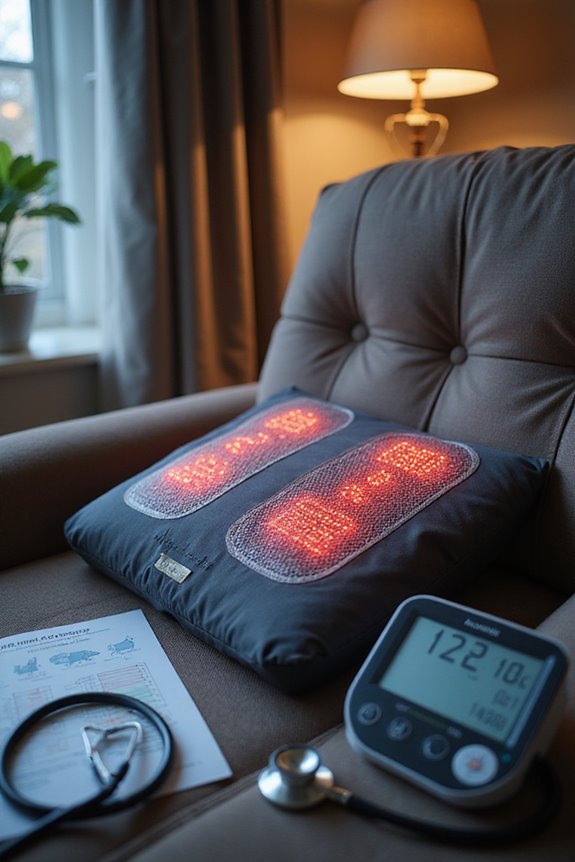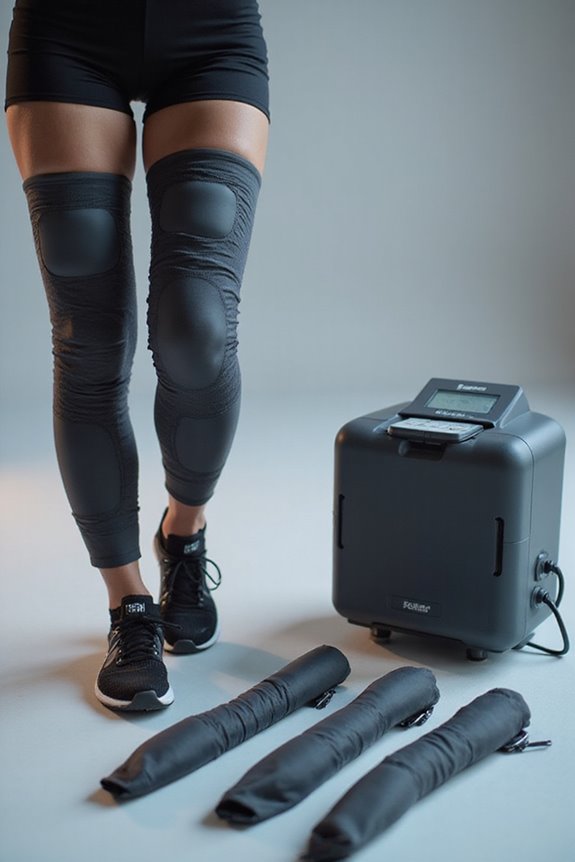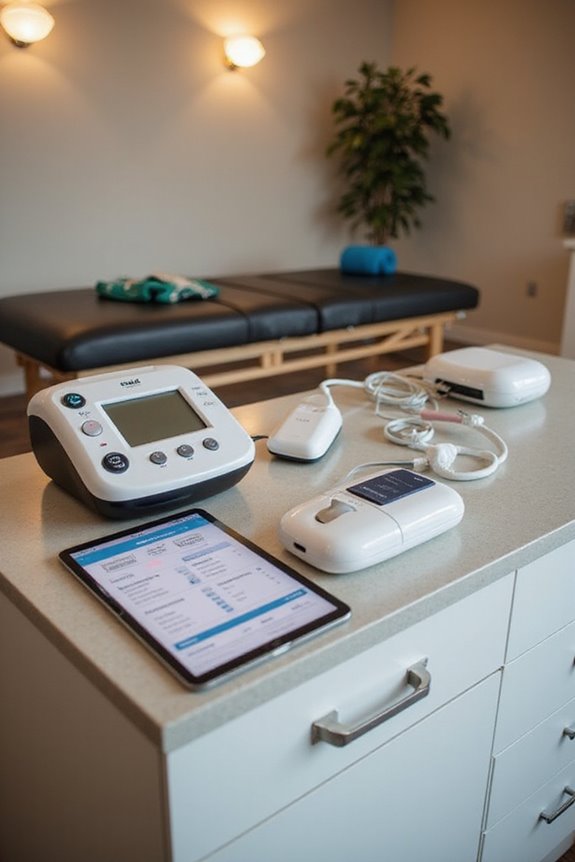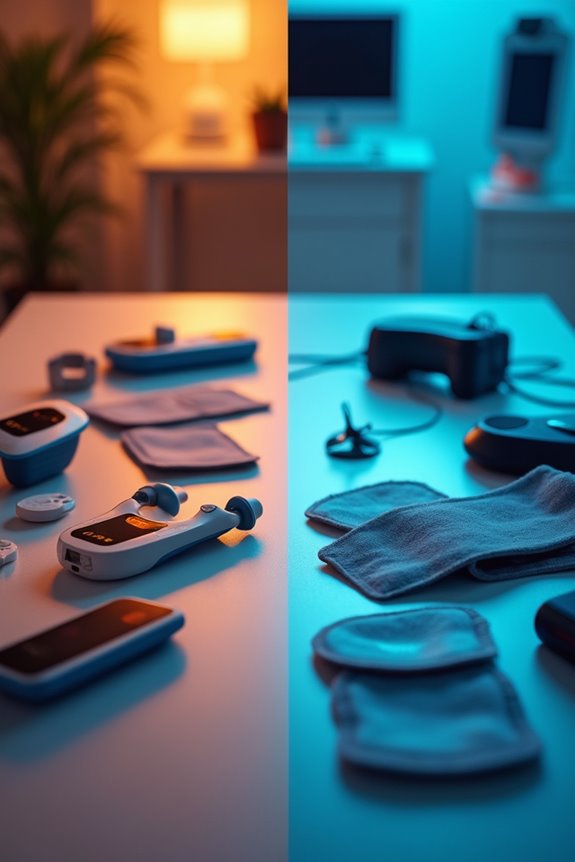Massage cushions markedly impact blood pressure through various mechanisms. They reduce cortisol levels by approximately -2.68 µg/dL, facilitating stress relief. Regular use correlates with a reduction in systolic blood pressure, averaging around 10.4 mm Hg. These devices enhance relaxation and promote improved cardiovascular health. Additionally, adjustable intensity settings provide targeted relief. Overall, consistent use supports vascular health and aids in blood pressure management. Further exploration of these benefits can enhance understanding of their applications.
Key Takeaways
- Regular use of massage cushions can significantly reduce systolic blood pressure by an average of 10.4 mm Hg post-treatment.
- Deep tissue massage through cushions also decreases diastolic blood pressure by about 5.3 mm Hg.
- Massage cushions promote relaxation, which can lead to lower cortisol levels and improved blood pressure regulation.
- Consistent use of massage cushions enhances overall cardiovascular health and supports muscle recovery.
- Incorporating massage cushions into a comprehensive lifestyle strategy can optimize blood pressure control and support heart health.
The Impact of Massage Cushions on Stress Reduction
The impact of massage cushions on stress reduction can be observed through various physiological and psychological mechanisms. Regular use correlates with significant cortisol reduction, particularly in the afternoon, where levels drop by approximately -2.68 µg/dL. This decrease indicates a diminished physiological stress response.
- Lower cortisol levels contribute to overall stress alleviation.
- Users often report mood enhancement, linked to increased serotonin and dopamine levels.
Studies have shown improved mental well-being alongside reduced depression rates.
– Enhanced mood profiles and subjective health status further support the psychological benefits of massage cushions.
These findings suggest that massage cushions are effective tools in managing stress and promoting emotional wellness, making them valuable additions to routine self-care practices.
Mechanisms Behind Blood Pressure Regulation
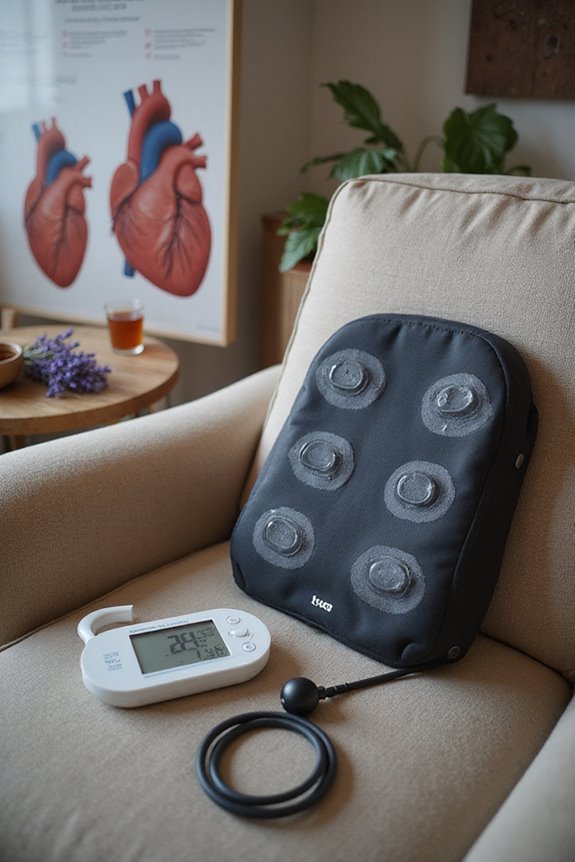
Understanding the mechanisms behind blood pressure regulation is essential for recognizing how various physiological systems interact to maintain cardiovascular stability.
Baroreceptor Function
- Baroreceptors in the aortic arch and carotid sinus detect arterial pressure changes through vessel wall stretch.
- Increased blood pressure elevates baroreceptor firing rates, triggering the medullary cardiovascular center to enhance parasympathetic activity, lowering heart rate and inducing vasodilation.
Hormonal Regulation
- The Renin-Angiotensin-Aldosterone System (RAAS) responds to low renal perfusion, releasing renin to produce angiotensin II, a powerful vasoconstrictor.
- Antidiuretic hormone (ADH) increases blood volume by promoting water reabsorption, while Atrial Natriuretic Peptide (ANP) counteracts this by inducing vasodilation and promoting diuresis.
These mechanisms guarantee immediate and sustained blood pressure regulation.
Different Types of Massage and Their Effects
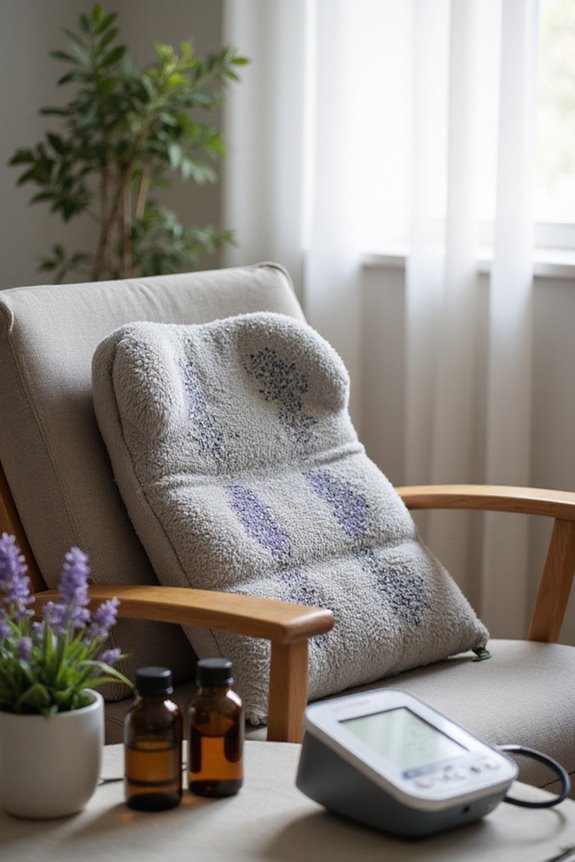
Various types of massage therapies exhibit distinct effects on blood pressure, influencing both systolic and diastolic readings in different ways.
Swedish Massage Benefits
- Associated with a reduction of approximately 1.8 mm Hg in systolic blood pressure.
- No notable increase in diastolic blood pressure noted.
- Utilizes gentle strokes that promote relaxation.
Trigger Point Effects
- Linked to increases in both systolic and diastolic blood pressure.
- Potentially painful, may activate the sympathetic nervous system.
- Caution advised for hypertensive individuals.
Sports Massage Risks
- Typically raises systolic blood pressure post-session.
- Combined with trigger point therapy, it considerably elevates blood pressure.
Deep Tissue Considerations
- Generally shows no considerable effects on blood pressure.
- Duration and pressure have not demonstrated marked impacts.
The Role of Deep Tissue Massage in Hypertension Management

Deep tissue massage plays a significant role in hypertension management, offering measurable benefits for blood pressure regulation. Clinical research indicates that this type of massage can lead to an average reduction in systolic blood pressure of approximately 10.4 mm Hg and diastolic blood pressure by about 5.3 mm Hg.
Notably, heart rate decreases by an average of 10.8 beats per minute post-treatment, enhancing overall cardiovascular health. Sessions typically last between 45 to 60 minutes, often in calming environments, which further supports relaxation.
The mechanisms include improved blood circulation and reduced peripheral vascular resistance, both contributing to lower blood pressure levels. These findings highlight the effectiveness of massage therapy as an adjunct intervention in managing hypertension.
Physiological Benefits of Enhanced Blood Circulation
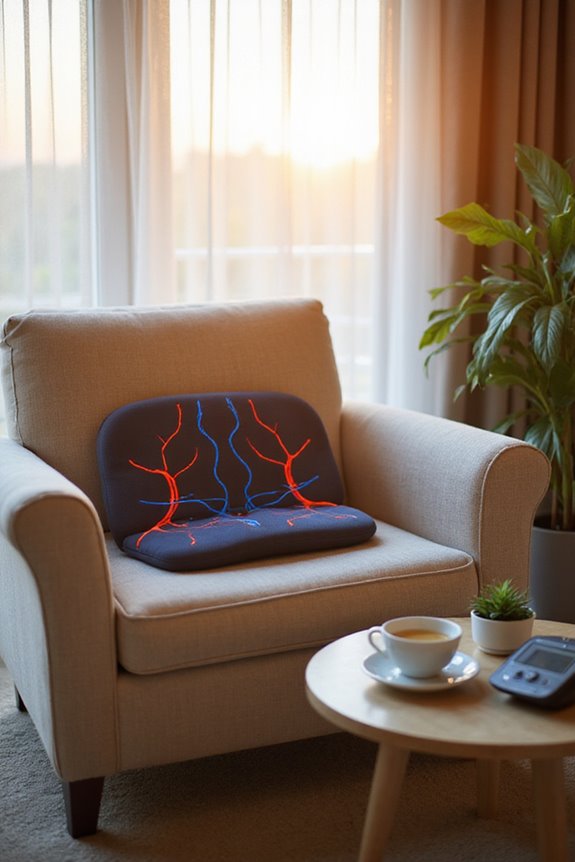
Enhanced blood circulation, which can be considerably improved through massage therapy, offers numerous physiological benefits that contribute to overall health.
Key Benefits:
- Improved Nutrient Delivery: Enhanced circulation supports the efficient transport of oxygen and nutrients to tissues and organs, maximizing body function.
- Vasodilation Effects: Massage promotes vasodilation, lowering blood pressure and reducing vascular resistance within the circulatory system.
- Muscle and Tissue Health: Increased blood flow aids in muscle repair, reduces tightness, and mitigates fatigue by flushing out metabolic wastes.
- Lymphatic Support: Enhanced circulation assists lymphatic function, clearing toxins and reducing swelling.
- Systemic Health Improvements: Efficient nutrient delivery correlates with decreased inflammation, better mobility, and improved overall well-being. Regular use of neck massagers can further enhance these benefits by promoting lymphatic drainage and relaxation.
These benefits highlight the essential role of massage in promoting optimal circulatory health and overall physiological function.
Massage Cushions in Hypertensive Pregnancy
Massage cushions represent a potential therapeutic tool in managing hypertensive pregnancy, as their use necessitates careful consideration due to the delicate nature of this condition.
- Safety Precautions: Caution is essential, as blood pressure fluctuations may occur. Light-pressure massage can lower blood pressure, while deep-pressure may elevate it.
- Medical Clearance: Pregnant women with hypertension should seek medical clearance before utilizing these devices to avoid complications such as preeclampsia or miscarriage.
- Supervision: Ideally, use should be under the guidance of healthcare providers specializing in prenatal care.
- Device Selection: Not all massage cushions are pregnancy-safe; validated models must be chosen to guarantee safety during use.
Regular Use and Overall Health Benefits
Regular use of massage cushions offers several health benefits that extend beyond mere relaxation.
- Blood Pressure Management: Regular massage has demonstrated an average systolic reduction of 10.4 mm Hg and diastolic reduction of 5.3 mm Hg, contributing to long-term benefits for cardiovascular health.
- Enhanced Circulation: Techniques such as air compression improve blood flow, facilitating better oxygen delivery and nutrient flow, which are essential for overall wellness.
- Stress Reduction: By lowering cortisol levels and promoting relaxation, massage cushions can positively influence the autonomic nervous system, reducing cardiac workload and enhancing cardiovascular resilience. Additionally, the inclusion of heat functionality benefits can further improve blood circulation and deepen relaxation.
Practical Applications for Home Use
Practical applications of massage cushions for home use can markedly contribute to blood pressure management. These cushions utilize various massage techniques, such as kneading and air compression, to enhance relaxation and improve circulation.
- Regular sessions of 15 to 30 minutes can yield significant benefits.
- Cushions that offer multiple massage types allow for personalized therapy at home.
- Adjustable intensity settings enhance comfort and effectiveness.
- Incorporating a 3-in-1 back massager can provide targeted relief for muscle tension, further supporting blood pressure health.
For ideal results, it is essential to create a calm environment during use. Consistent integration of these cushions into daily routines not only promotes home relaxation but also supports sustained blood pressure improvements. Ultimately, the practical use of massage cushions represents a valuable tool for individuals seeking to manage their blood pressure effectively in the comfort of their own homes.
Combining Massage With Lifestyle Changes for Better Outcomes
Integrating massage therapy with lifestyle modifications can greatly enhance blood pressure management outcomes. Research indicates that regular massage sessions, when combined with lifestyle integration strategies, yield significant benefits for cardiovascular health.
- Massage Frequency: Consistent massage therapy supports muscle recovery and vascular health post-exercise.
- Stress Management: Incorporating massage into stress-reduction routines can improve psychological well-being alongside dietary changes.
- Synergistic Effects: Pairing massage with lifestyle adjustments, such as weight management and sodium reduction, optimizes blood pressure control.
- Cardiovascular Fitness: Regular massage alongside physical activity promotes blood pressure stability and overall heart health.
- Sleep Hygiene: Enhanced sleep quality through massage can further regulate blood pressure levels.
Incorporating these strategies fosters a holistic approach to managing blood pressure effectively.
Frequently Asked Questions
Can Massage Cushions Be Used Daily for Best Results?
Daily usage of massage cushions is recommended, providing significant health benefits such as stress reduction and enhanced circulation. Regular integration into wellness routines fosters a sense of community, promoting shared experiences in achieving overall well-being.
Are There Any Contraindications for Using Massage Cushions?
There are several contraindications for using massage cushions, particularly concerning specific health conditions. Users should adhere to guidelines, avoiding use during pregnancy, infections, or with uncontrolled hypertension to guarantee safety and prevent complications.
How Long Should Each Massage Session Last?
Research suggests that ideal timing for massage session duration begins at 15 minutes, gradually increasing to 45-60 minutes for enhanced effects. This approach fosters a sense of community in promoting overall well-being and relaxation.
Do Massage Cushions Require Regular Maintenance?
In an age of advanced technology, massage cushions indeed require regular maintenance. Adhering to cleaning guidelines and maintenance frequency guarantees longevity, enhancing user experience while fostering a sense of community among those who cherish relaxation.
Can Children Safely Use Massage Cushions?
The safety of children using massage cushions hinges on proper supervision and equipment adjustments. When used correctly, these cushions can offer massage benefits, but prioritizing child safety is essential to prevent potential risks and injuries.

